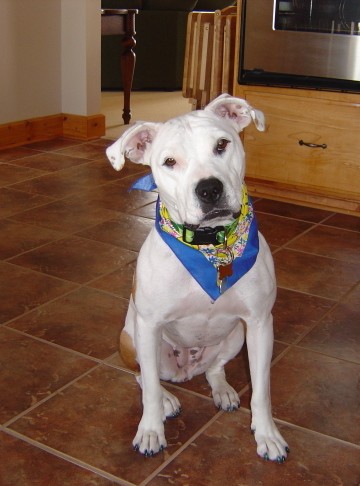
|
 |
 |
Training Your Dog to Sit With Clicker TrainingHow to Say "Sit" in Dog Speak Training your dog to sit is one of the easiest places to
start teaching obedience. A dog that reliably responds to the
sit command can be prevented from
jumping on people, running off, chasing other animals--any
number of undesirable behaviors that are incompatible with sitting. Training your dog to sit is one of the easiest places to
start teaching obedience. A dog that reliably responds to the
sit command can be prevented from
jumping on people, running off, chasing other animals--any
number of undesirable behaviors that are incompatible with sitting.
So, it's no wonder that you may gravitate towards teaching your dog to sit before other commands. Moreover, sitting is something a dog does naturally. You aren't asking your dog to do something she doesn't know how to do. You are merely putting a behavior that's already occuring on cue. If you've tried teaching your dog to sit by physically forcing her into position while saying "sit", you're in for a pleasant surprise. This is a totally hands-off method that not only accomplishes training your dog to sit, but more importantly, teaches your dog to learn. Obedience training doesn't have to be an exercise in frustration. It can and should be a fun, rewarding experience that deepens your relationship with your dog. This article assumes that you have already charged the clicker so that your dog knows the meaning of the click. If you haven't done this preliminary step, follow the above link and read that article before proceeding. Take your dog to a quiet area with as few distractions as possible. Indoors is usually best. Have treats and the clicker with you. Don't give your dog any commands at this point. Resist the temptation to say sit to see if your dog might do it. Instead, wait for your dog to sit. (She will eventually.) As soon as her bottom touches the ground--click and treat. Some dogs will break the sit to get the treat from you or shortly after getting the treat. That's fine at this point. You'll work on extending the length of the sit after you've put the behavior on cue. For now, you're simply teaching her that when she sits, something good happens. If your dog doesn't spontaneously get up after getting the treat, you'll need to coax her up. Merely walking away may get her to follow you--especially since she knows you have treats. Or you may need to crouch down, pat your thigh or whatever you normally do to get her to come to you. Once she's up, start watching for the next sit. Click and treat when it happens. If she lays down instead of sitting, coax her back up as before. Do not click and treat for anything other than a sit. Continue clicking and treating for subsequent sits. At some point, it will dawn on your dog that the act of sitting gets her a treat. When this happens she will most likely begin intentionally sitting in an effort to get you to give her a treat. She'll probably look at you as if to say, "Where's my treat?" This may or may not occur during the first session. I'm not a fan of long training sessions. A five minute upbeat, positive exchange is far superior to an hour long marathon that ends with your dog being tired and distracted and you feeling frustrated. Five to fifteen minutes of training at a time seems to work well for most dogs. If you find yourself getting impatient or annoyed, end the session and come back to it little later. All this is to say, avoid the mistake of extending the training session in hopes of reaching a certain benchmark. It's fine to have multiple sessions throughout the day, but keep them short. Your goal is to end on a high note--before your dog gets bored with the exercise. Now, back to the point where your dog is sitting and giving you that "Where's the treat" look. Whether it's the first, fifth or fifteenth session, when this happens, you can begin adding the command. At first, simply say "sit" as your dog is sitting--then, of course, click and treat. Do this several times. Next, you are going to up the ante by giving the command "sit" before your dog sits. Any time your dog sits when you give the command, click and treat. If your dog sits when you haven't given the command--no treat. If your dog doesn't sit when you give the command--no treat. From now on, only sitting when you've given the command gets a treat. Don't scold your dog for an incorrect response. Be patient. You've changed up the rules a bit and your dog may appear to regress at first while she's trying to figure out what you want. Remember, you're not just training your dog to sit. You are teaching your dog how to learn. Once your dog is reliably sitting on cue, you can begin refining her skill by extending the length of time she must stay in the sit before she gets the click and treat. This is called shaping. Start with a couple of seconds and gradually work up to a minute or longer or until you release her. You should also begin training your dog to sit around distractions such as other people, animals or being outdoors. You can shape other elements of the sit as well. For instance, you can begin treating only for a sit in which your dog sits squarely on her haunches (not to the side on one of her hips). You can shape how quickly she sits by only clicking and treating her when she sits immediately on cue. The key here is to only shape one element at a time. Work on length of sit only. Or work on quickness of response only. But, not both at the same time. And, remember each time you up the ante, it may take your dog several attempts to figure out what you want. By giving her the opportunity to figure things out though, she is learning to problem solve. This will pay dividends in faster learning down the road. And, the bond that develops between you and your dog as a result is nothing short of amazing. Clicker trainers believe that dogs, not unlike humans, learn best when they figure something out for themselves. That said, if waiting for your dog to sit during that initial session is proving fruitless, there is another method of training your dog to sit with a clicker that can speed things along. It's called luring. Return from Training Your Dog to Sit to Pit Bull Training Return from Training Your Dog to Sit to Pit Bull Homepage |
|
|
|
[?] Subscribe To This Site

|
||
 |
||
|
| ||





